A
Auto Express
Guest
This is the new Hyundai Tucson, the fourth generation of the brand’s global best-seller and rival to the Kia Sportage, Volkswagen Tiguan and Peugeot 3008.
It has undergone a total rethink inside and out, introducing a new and distinctive design language that will be kept unique to the Tucson. Combined with some key technology and chassis updates, it’s part of a grand plan hatched by the Korean brand to push its SUV further upmarket.
Hyundai previewed this new Tucson late in 2019 with the bold- looking Vision T concept. The production version features many of the Vision T’s styling cues, and it looks like little else in Hyundai’s line-up. The front is dominated by a new grille, with parametric detailing and integrated LED running lights that are designed to be completely hidden within the grille when the car is not being driven.
Compared with the conventional-looking current car, the new Tucson’s flanks are more sculpted, with dramatic creases, bold shoulders, squared-off wheelarches and a sweeping chrome trim line flowing in one arch from the car’s A-pillar to the C-pillar.
The tailgate is defined by a new full-width LED lighting bar with fang-like elements, while the lighting signature features a pattern that is similar to the front grille’s, and the design is repeated on the rugged-looking lower bumper section. The rear wiper blade is hidden under the spoiler, to make the tailgate’s surface as smooth as possible.

image
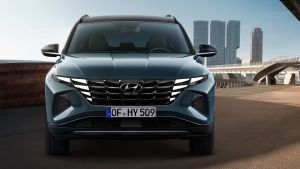
image
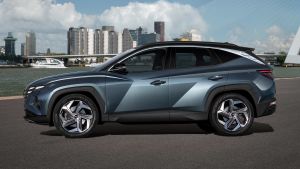
image
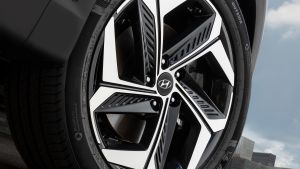
image
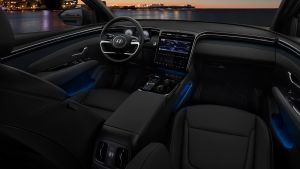
image
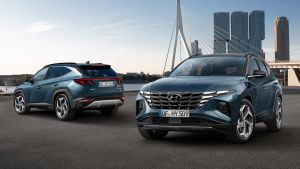
image
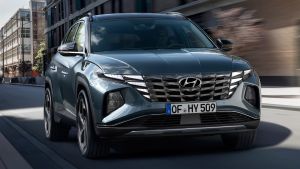
image
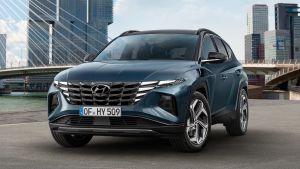
image
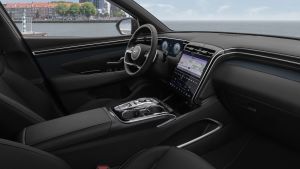
image

image

image

image
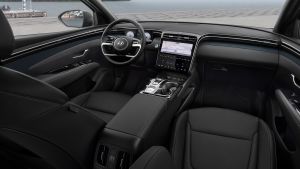
image
Hyundai’s SUV is marginally longer and wider than before, and the wheelbase has been extended by 10mm. The brand claims this results in up to 26mm more legroom for passengers, while the boot now offers a capacity of up to 620 litres in front-wheel-drive petrol models.
Alloy wheels ranging from 17 inches to 19 inches will be available, while Tucson customers will have nine exterior paint colours to choose from. Every finish can be combined with a contrasting roof.
The comprehensive transformation continues with an all-new interior; the dash is set low to increase forward visibility, and the design is defined by two chrome lines that sweep seamlessly around the doors, across the top of the dash and then flow downwards into a new higher centre console, which is at the driver’s hand level.
Hyundai says it has made improvements in material quality with the use of soft-touch plastics at hand height, while buyers will have the option of black or black-and-beige upholstery in leather or fabric, alongside a contrasting black-and-teal package. A total of 64 ambient cabin light colours can be selected, too.
Hyundai has completely removed the instrument cluster housing, with a tablet- style and configurable 10.25-inch digital instrument panel appearing ahead of a new steering wheel. Another 10.25-inch screen is used for the central display, and this includes Android Auto and Apple CarPlay capability. Google and Apple Calendar integration is a new feature, as are selectable user profiles. Last-mile navigation is a new feature, meaning if the driver can’t park at the exact destination, further directions will be sent to their smartphone for finishing the journey on foot. Live parking and traffic information is also part of the new navigation package.
The infotainment screen is part of a flush new centre console that uses touch-sensitive and illuminated buttons instead of physical switches. The gear selector has been changed to a compact shift-by-wire set-up, too.

image

image

image

image

image

image

image

image

image

image

image

image

image
Hyundai has given the engine line-up and chassis tech key updates, with electrification playing a big part. The entry-level car now has a 148bhp 1.6-litre petrol unit, a six-speed manual gearbox and either front or four-wheel drive.
Three 48-volt mild-hybrids will be available, including a 1.6-litre turbocharged four-cylinder petrol with 48-volt assistance and either 148bhp or 178bhp, plus optional four-wheel drive. Both are offered with the firm’s new six-speed Intelligent Manual Transmission – a manual box that doesn’t have a clutch pedal – or a seven-speed dual-clutch automatic. A 134bhp 48-volt diesel has been announced, too, but it may not come to the UK.
A hybrid version will also be offered from launch, combining the 1.6-litre petrol option with a 59bhp electric motor and a small 1.49kWh battery pack; the combined power will stand at 227bhp and 350Nm of torque. A six-speed automatic gearbox will be standard on that model, while all-wheel-drive versions of the Tucson Hybrid are available with a Terrain Control switch for driving off road. A plug-in hybrid model, also using the 1.6-litre engine, will arrive in 2021.
For the first time, customers will have two suspension set-ups to choose from. As part of the car’s push upmarket, electronically controlled adaptive dampers will be optional on high-spec Tucsons, with two profiles: a softer setting for when the car is in Normal and Eco drive modes, and a firmer set-up when the new Sport mode is selected. Doing this also alters the steering.
Hyundai has introduced plenty of new driver-assistance and safety features, with the most important being the availability of the firm’s Highway Drive Assist semi-autonomous capability. It can brake and accelerate the car automatically to keep a pre-set distance from other vehicles, while using Lane Follow Assist to keep the Tucson in lane on motorways and dual carriageways. Remote Smart Parking Assist is another new automated feature, which means the car can be summoned from a parking spot via a button on the key.
Prices for the Mk4 Tucson have yet to be announced, but they should rise over the outgoing model to at least £25,000 for the new entry-level version.
What are the best crossovers on sale right now? Click on our gallery below to find out...
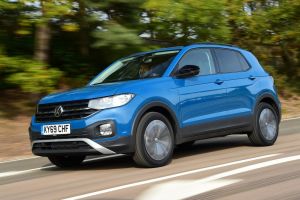
VW brings added kudos to the small SUV field.
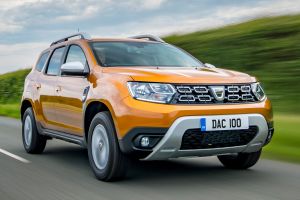
Lacks the latest tech, but space and price are hard to beat.

Clio based small SUV has plenty of equipment and rides well.
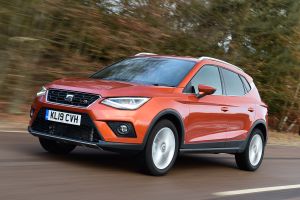
Oldest of the MQB- based SUVs but still a solid choice.
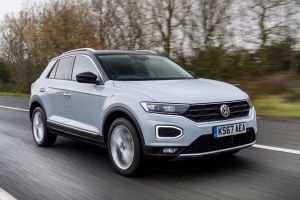
Golf based T-Roc is refined and has more space than T-Cross

Fiesta underpinnings means the Puma is fun-to-drive.

MINI Countryman High on quality and big on space and design, the MINI Countryman is more sporty than most crossovers.
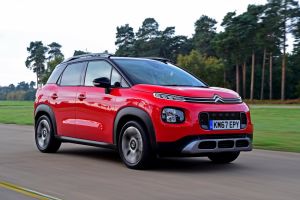
Suspension and seating are both comfort biased.
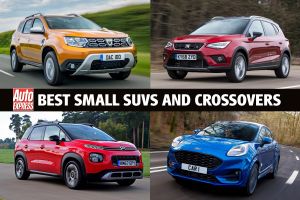
Best small SUVs and crossovers - header

Practical, good value and decent to drive, Kamiq is hard to beat.
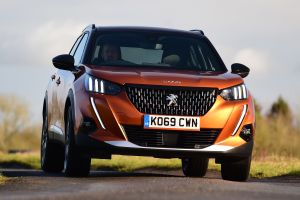
Planted and with precise handling, the 208 offers a comfortable rid
Continue reading...
It has undergone a total rethink inside and out, introducing a new and distinctive design language that will be kept unique to the Tucson. Combined with some key technology and chassis updates, it’s part of a grand plan hatched by the Korean brand to push its SUV further upmarket.
Hyundai previewed this new Tucson late in 2019 with the bold- looking Vision T concept. The production version features many of the Vision T’s styling cues, and it looks like little else in Hyundai’s line-up. The front is dominated by a new grille, with parametric detailing and integrated LED running lights that are designed to be completely hidden within the grille when the car is not being driven.
Compared with the conventional-looking current car, the new Tucson’s flanks are more sculpted, with dramatic creases, bold shoulders, squared-off wheelarches and a sweeping chrome trim line flowing in one arch from the car’s A-pillar to the C-pillar.
The tailgate is defined by a new full-width LED lighting bar with fang-like elements, while the lighting signature features a pattern that is similar to the front grille’s, and the design is repeated on the rugged-looking lower bumper section. The rear wiper blade is hidden under the spoiler, to make the tailgate’s surface as smooth as possible.

image

image

image

image

image

image

image

image

image

image

image

image

image
Hyundai’s SUV is marginally longer and wider than before, and the wheelbase has been extended by 10mm. The brand claims this results in up to 26mm more legroom for passengers, while the boot now offers a capacity of up to 620 litres in front-wheel-drive petrol models.
Alloy wheels ranging from 17 inches to 19 inches will be available, while Tucson customers will have nine exterior paint colours to choose from. Every finish can be combined with a contrasting roof.
The comprehensive transformation continues with an all-new interior; the dash is set low to increase forward visibility, and the design is defined by two chrome lines that sweep seamlessly around the doors, across the top of the dash and then flow downwards into a new higher centre console, which is at the driver’s hand level.
Hyundai says it has made improvements in material quality with the use of soft-touch plastics at hand height, while buyers will have the option of black or black-and-beige upholstery in leather or fabric, alongside a contrasting black-and-teal package. A total of 64 ambient cabin light colours can be selected, too.
Hyundai has completely removed the instrument cluster housing, with a tablet- style and configurable 10.25-inch digital instrument panel appearing ahead of a new steering wheel. Another 10.25-inch screen is used for the central display, and this includes Android Auto and Apple CarPlay capability. Google and Apple Calendar integration is a new feature, as are selectable user profiles. Last-mile navigation is a new feature, meaning if the driver can’t park at the exact destination, further directions will be sent to their smartphone for finishing the journey on foot. Live parking and traffic information is also part of the new navigation package.
The infotainment screen is part of a flush new centre console that uses touch-sensitive and illuminated buttons instead of physical switches. The gear selector has been changed to a compact shift-by-wire set-up, too.

image

image

image

image

image

image

image

image

image

image

image

image

image
Hyundai has given the engine line-up and chassis tech key updates, with electrification playing a big part. The entry-level car now has a 148bhp 1.6-litre petrol unit, a six-speed manual gearbox and either front or four-wheel drive.
Three 48-volt mild-hybrids will be available, including a 1.6-litre turbocharged four-cylinder petrol with 48-volt assistance and either 148bhp or 178bhp, plus optional four-wheel drive. Both are offered with the firm’s new six-speed Intelligent Manual Transmission – a manual box that doesn’t have a clutch pedal – or a seven-speed dual-clutch automatic. A 134bhp 48-volt diesel has been announced, too, but it may not come to the UK.
A hybrid version will also be offered from launch, combining the 1.6-litre petrol option with a 59bhp electric motor and a small 1.49kWh battery pack; the combined power will stand at 227bhp and 350Nm of torque. A six-speed automatic gearbox will be standard on that model, while all-wheel-drive versions of the Tucson Hybrid are available with a Terrain Control switch for driving off road. A plug-in hybrid model, also using the 1.6-litre engine, will arrive in 2021.
For the first time, customers will have two suspension set-ups to choose from. As part of the car’s push upmarket, electronically controlled adaptive dampers will be optional on high-spec Tucsons, with two profiles: a softer setting for when the car is in Normal and Eco drive modes, and a firmer set-up when the new Sport mode is selected. Doing this also alters the steering.
Hyundai has introduced plenty of new driver-assistance and safety features, with the most important being the availability of the firm’s Highway Drive Assist semi-autonomous capability. It can brake and accelerate the car automatically to keep a pre-set distance from other vehicles, while using Lane Follow Assist to keep the Tucson in lane on motorways and dual carriageways. Remote Smart Parking Assist is another new automated feature, which means the car can be summoned from a parking spot via a button on the key.
Prices for the Mk4 Tucson have yet to be announced, but they should rise over the outgoing model to at least £25,000 for the new entry-level version.
What are the best crossovers on sale right now? Click on our gallery below to find out...

VW brings added kudos to the small SUV field.

Lacks the latest tech, but space and price are hard to beat.

Clio based small SUV has plenty of equipment and rides well.

Oldest of the MQB- based SUVs but still a solid choice.

Golf based T-Roc is refined and has more space than T-Cross

Fiesta underpinnings means the Puma is fun-to-drive.

MINI Countryman High on quality and big on space and design, the MINI Countryman is more sporty than most crossovers.

Suspension and seating are both comfort biased.

Best small SUVs and crossovers - header

Practical, good value and decent to drive, Kamiq is hard to beat.

Planted and with precise handling, the 208 offers a comfortable rid
Continue reading...
